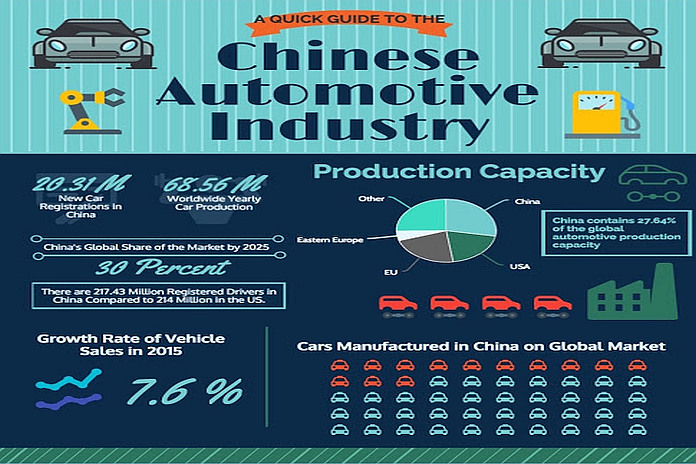The Chinese Automotive Market: Challenges And Opportunities For Brands Like BMW And Porsche

Table of Contents
Challenges in the Chinese Automotive Market
The Chinese automotive market is fiercely competitive, demanding strategic agility and deep market understanding from international brands. Navigating this landscape requires a keen awareness of several key challenges.
Intense Competition
The Chinese automotive market is saturated. Established players face intense pressure not only from other international brands but also from rapidly innovating domestic manufacturers. This leads to fierce price competition and pressure on profit margins.
- Examples of competitive Chinese brands: Nio, XPeng, Li Auto, BYD, and others are rapidly gaining market share with technologically advanced vehicles and competitive pricing. These brands are not only challenging established players in the mainstream segment but are also making inroads into the luxury market.
- Price wars impacting profit margins: The intense competition often results in price wars, squeezing profit margins for even the most established luxury brands. Maintaining profitability requires strategic pricing and a clear differentiation strategy.
- Need for differentiation: To stand out, luxury brands must offer unique selling propositions beyond just price. This includes focusing on brand heritage, superior craftsmanship, innovative technology, and exceptional customer service.
Evolving Consumer Preferences
Chinese consumers are discerning and tech-savvy. They demand advanced features and a seamless digital experience, far beyond what was expected just a few years ago.
- Importance of digital marketing: Reaching Chinese consumers requires a strong online presence and sophisticated digital marketing strategies, leveraging popular social media platforms and e-commerce channels.
- Integrating smart technology: Features like advanced driver-assistance systems (ADAS), connectivity, and sophisticated infotainment systems are no longer luxury extras but essential features expected in even entry-level vehicles. Luxury brands must offer cutting-edge technology to remain competitive.
- Catering to younger demographics: A significant portion of the growth in the Chinese automotive market is driven by younger, tech-savvy consumers. Luxury brands need to tailor their marketing and product offerings to appeal to this demographic.
Regulatory Hurdles and Government Policies
Navigating the Chinese regulatory landscape presents a unique set of challenges for international automakers. Complex regulations and government policies aimed at supporting domestic brands create an uneven playing field.
- Specific examples of regulations: Regulations concerning emissions standards (e.g., the increasingly stringent CAFC standards), safety standards, and import tariffs significantly impact pricing and profitability.
- Impact on pricing: Import tariffs and other regulations can inflate the cost of imported vehicles, making them less competitive compared to locally manufactured alternatives.
- Strategies for compliance: International brands must invest heavily in compliance and localization to navigate these regulatory hurdles effectively. This includes building strong relationships with regulatory bodies and adapting their products to meet local standards.
Opportunities in the Chinese Automotive Market
Despite the challenges, the Chinese automotive market presents enormous opportunities for brands willing to adapt and invest strategically.
Huge Market Size and Growth Potential
The sheer size of the Chinese automotive market is unparalleled. Its continued growth, fuelled by a burgeoning middle class, presents immense potential for revenue generation.
- Market size statistics: China consistently ranks as the world's largest automotive market, with sales figures exceeding those of all other countries combined.
- Projected growth rates: While the overall growth rate may fluctuate, the luxury segment is expected to continue expanding, driven by increasing disposable incomes and a desire for premium products.
- Segmentation of the luxury car market: Understanding the diverse segments within the luxury market—from entry-level luxury to ultra-luxury—is crucial for targeting specific consumer groups effectively.
Rising Demand for Luxury Vehicles
The Chinese luxury car market is booming, offering significant opportunities for established brands with strong brand equity.
- Growth in luxury car sales: Sales of luxury vehicles in China are consistently increasing, demonstrating a strong demand for premium brands.
- Consumer preference trends: Chinese consumers increasingly associate luxury car ownership with success and status, driving demand for prestigious brands.
- Brand loyalty analysis: While brand loyalty exists, it's not as entrenched as in some other markets, providing opportunities for brands to attract new customers through targeted marketing and product innovation.
Potential for Strategic Partnerships and Localization
Collaborating with local partners can provide valuable insights and facilitate smoother market entry and operations. Localization of products and services is crucial.
- Examples of successful partnerships: Many international brands have successfully partnered with Chinese companies to leverage local expertise in distribution, marketing, and manufacturing.
- Benefits of localization: Adapting products to meet specific consumer needs, including offering features tailored to the Chinese market and providing localized customer service, is essential for success.
- Strategies for cultural adaptation: Understanding and respecting Chinese culture is paramount for successful marketing and brand building. This includes sensitivity towards local customs and preferences in advertising and communication.
Conclusion
The Chinese automotive market presents a double-edged sword for brands like BMW and Porsche. While fierce competition and regulatory hurdles pose significant challenges, the sheer market size, increasing demand for luxury vehicles, and potential for strategic partnerships offer immense opportunities for growth. Successfully navigating this dynamic landscape requires a deep understanding of consumer preferences, a commitment to innovation, and a flexible strategy that adapts to the evolving regulatory environment. To thrive in the competitive Chinese automotive market, brands must prioritize localization, technological advancements, and strong relationships with local partners. Understanding the nuances of the Chinese automotive market is critical for long-term success. Don't miss out on the potential of this vast market; invest time in understanding the intricacies of the Chinese automotive market to capture its significant opportunities.

Featured Posts
-
 Ai Driven Podcast Creation Transforming Scatological Data Into Engaging Content
Apr 28, 2025
Ai Driven Podcast Creation Transforming Scatological Data Into Engaging Content
Apr 28, 2025 -
 A Deep Dive Into The Beliefs Of Luigi Mangiones Supporters
Apr 28, 2025
A Deep Dive Into The Beliefs Of Luigi Mangiones Supporters
Apr 28, 2025 -
 Final Days Of Hudsons Bay 70 Off Liquidation Event
Apr 28, 2025
Final Days Of Hudsons Bay 70 Off Liquidation Event
Apr 28, 2025 -
 Silent Divorce Recognizing The Telltale Signs Of Marital Dissolution
Apr 28, 2025
Silent Divorce Recognizing The Telltale Signs Of Marital Dissolution
Apr 28, 2025 -
 Browns Select Shedeur Sanders In Nfl Draft
Apr 28, 2025
Browns Select Shedeur Sanders In Nfl Draft
Apr 28, 2025
Latest Posts
-
 Red Sox Breakout Season Predicting The Next Star
Apr 28, 2025
Red Sox Breakout Season Predicting The Next Star
Apr 28, 2025 -
 Under The Radar Red Sox Player Poised For Breakout Season
Apr 28, 2025
Under The Radar Red Sox Player Poised For Breakout Season
Apr 28, 2025 -
 Updated Red Sox Lineup Casas Moved Down Outfielder Returns From Injury
Apr 28, 2025
Updated Red Sox Lineup Casas Moved Down Outfielder Returns From Injury
Apr 28, 2025 -
 Red Sox Starting Lineup Casas Position Shift Outfielders Comeback
Apr 28, 2025
Red Sox Starting Lineup Casas Position Shift Outfielders Comeback
Apr 28, 2025 -
 Red Sox Lineup Shakeup Casas Demoted Struggling Outfielder Returns
Apr 28, 2025
Red Sox Lineup Shakeup Casas Demoted Struggling Outfielder Returns
Apr 28, 2025
